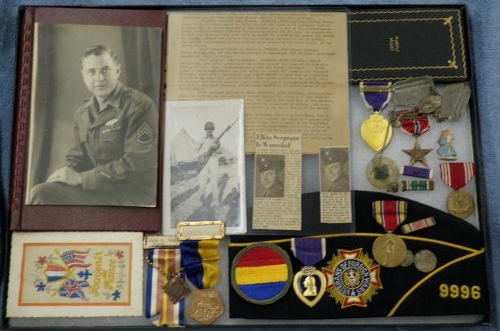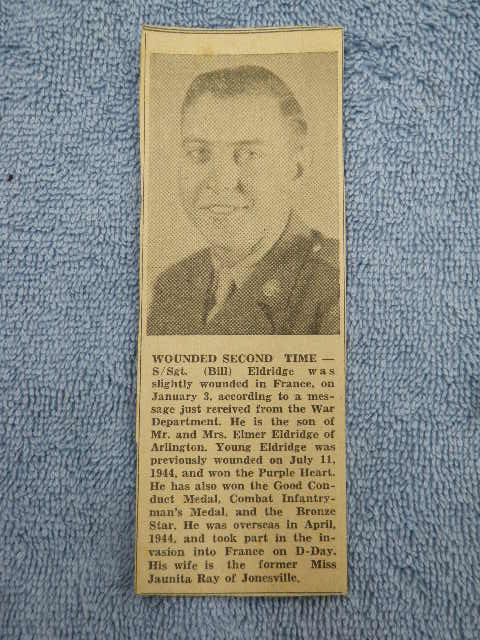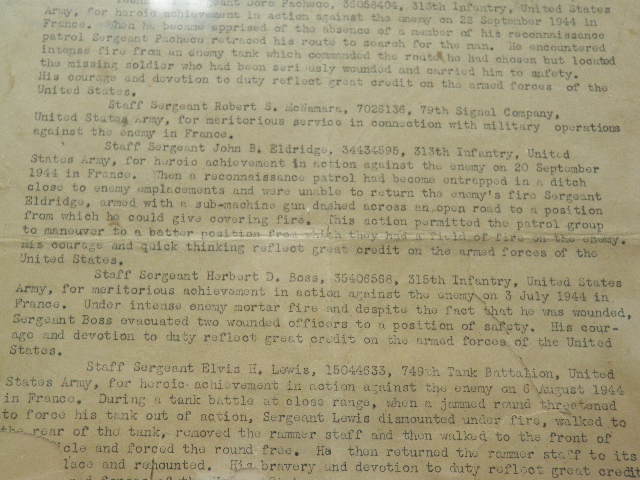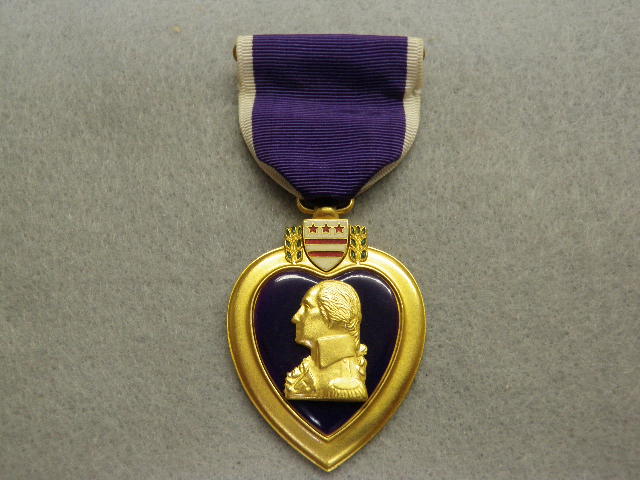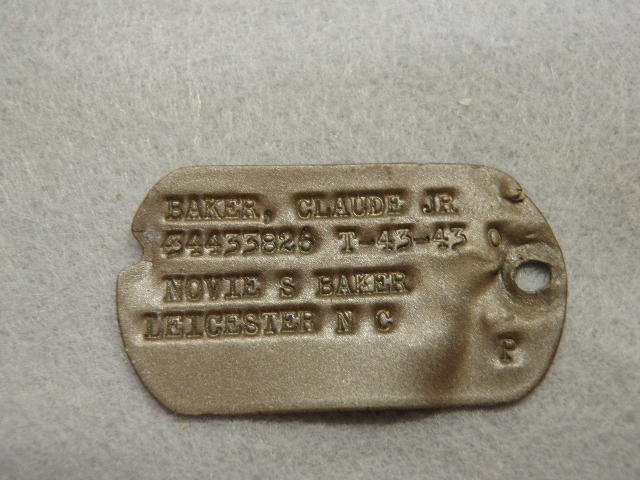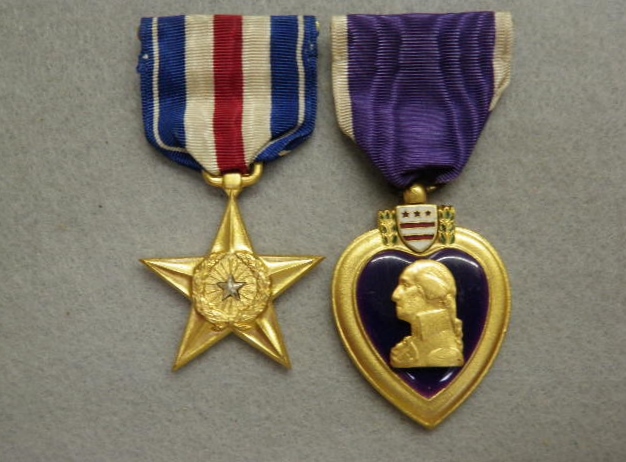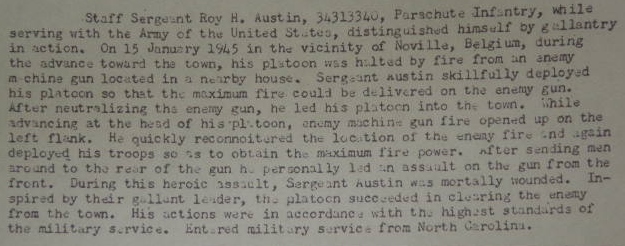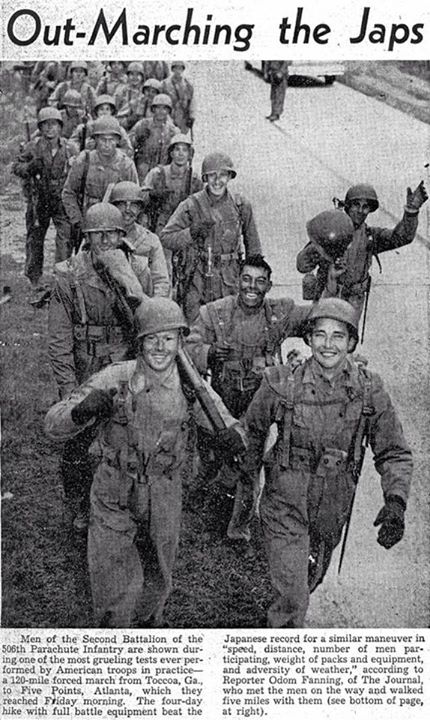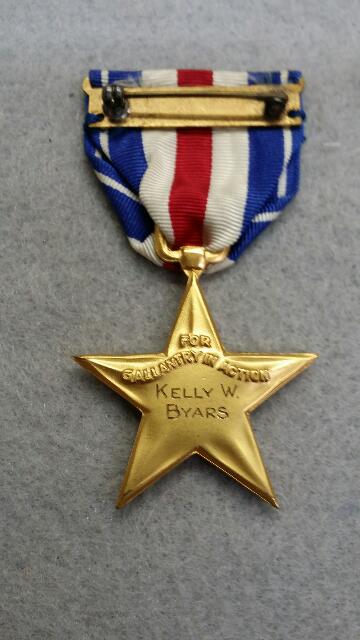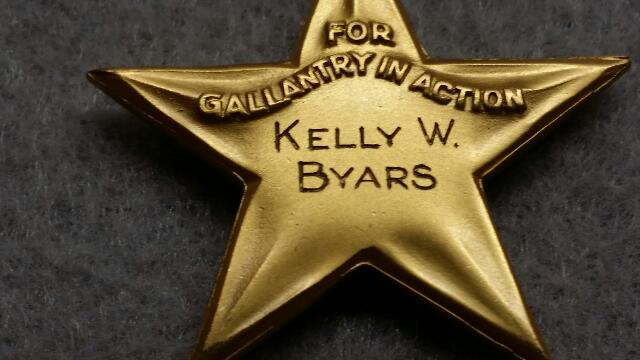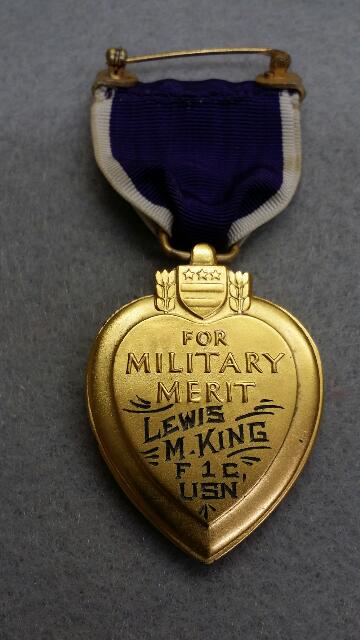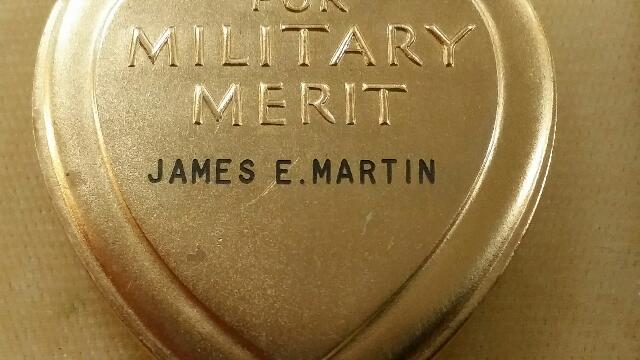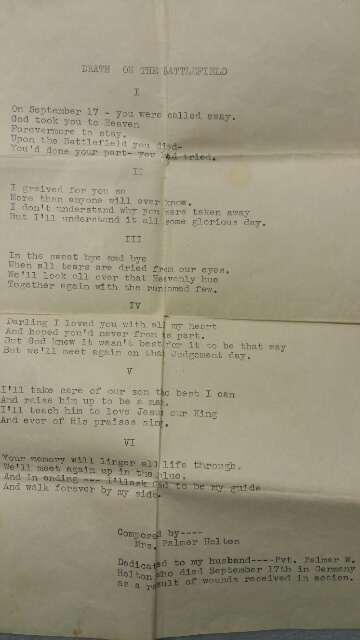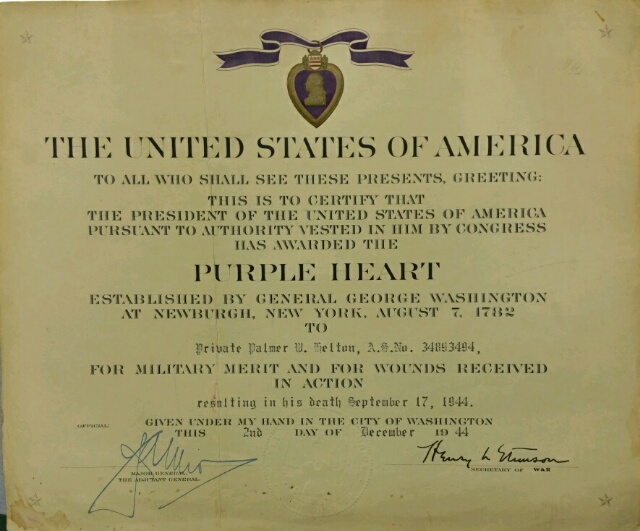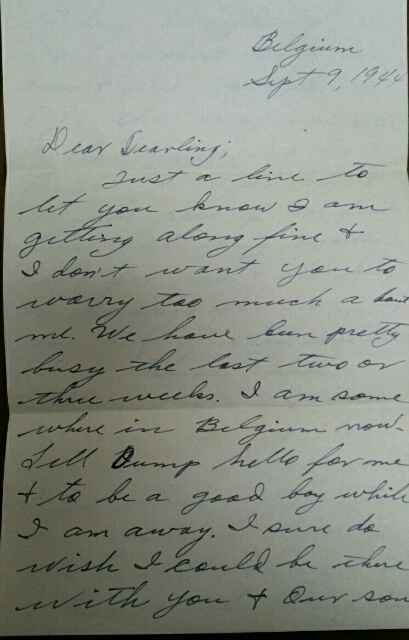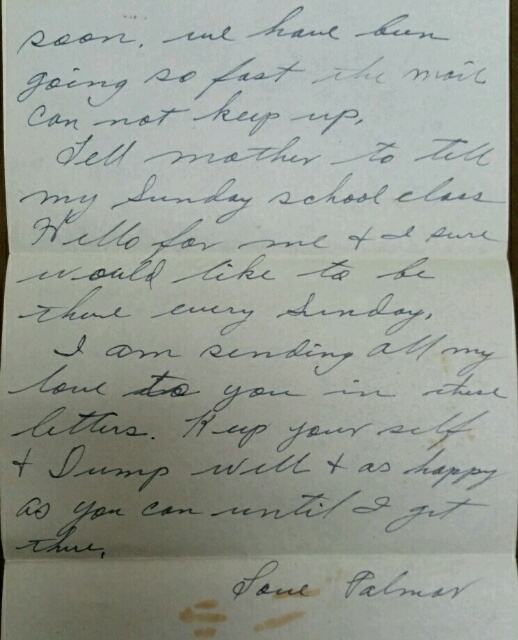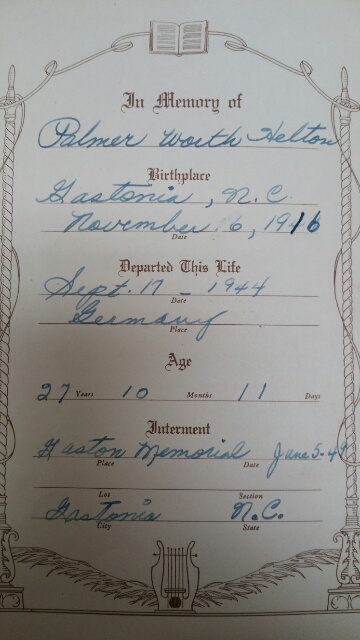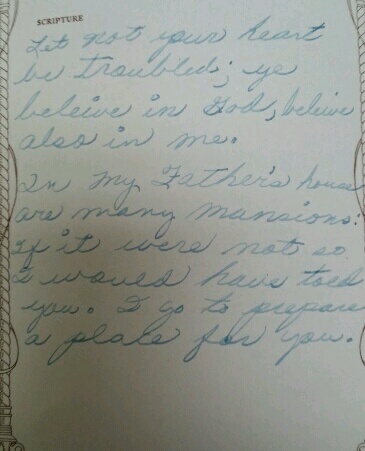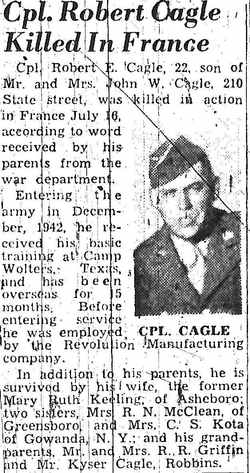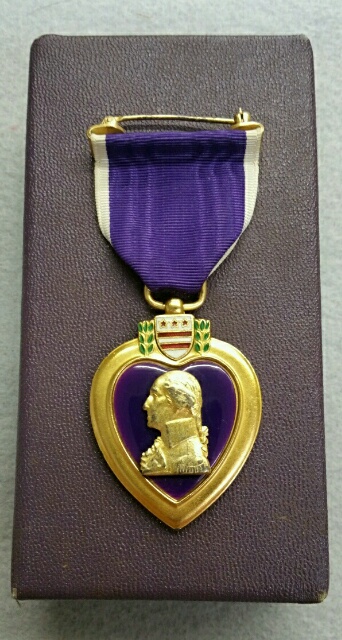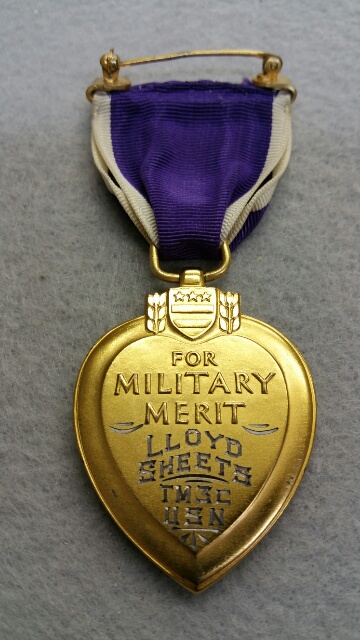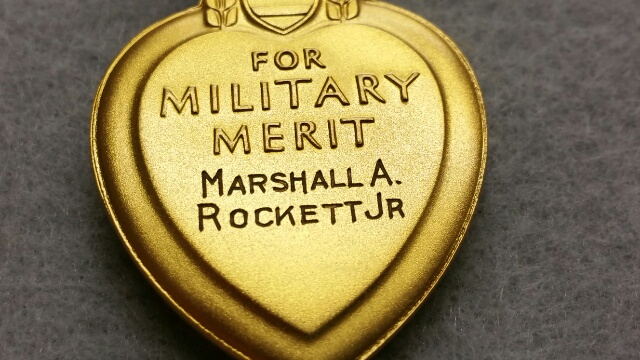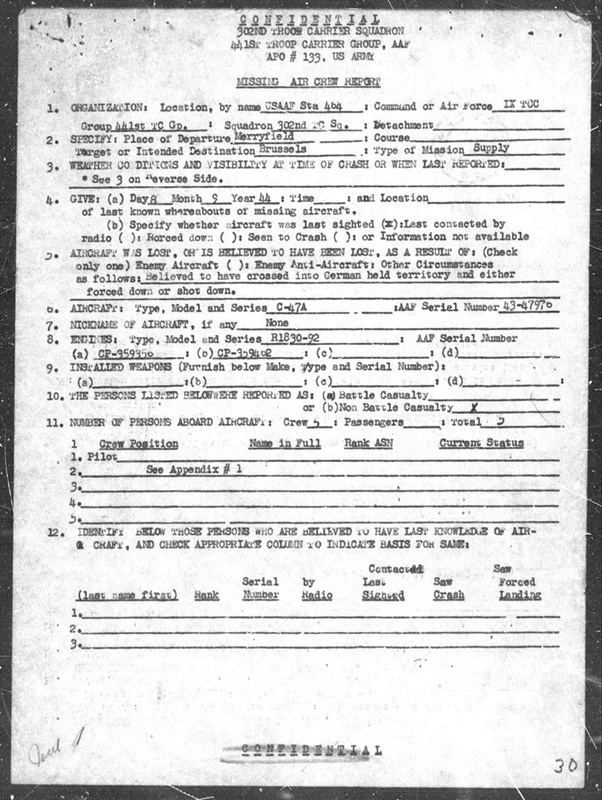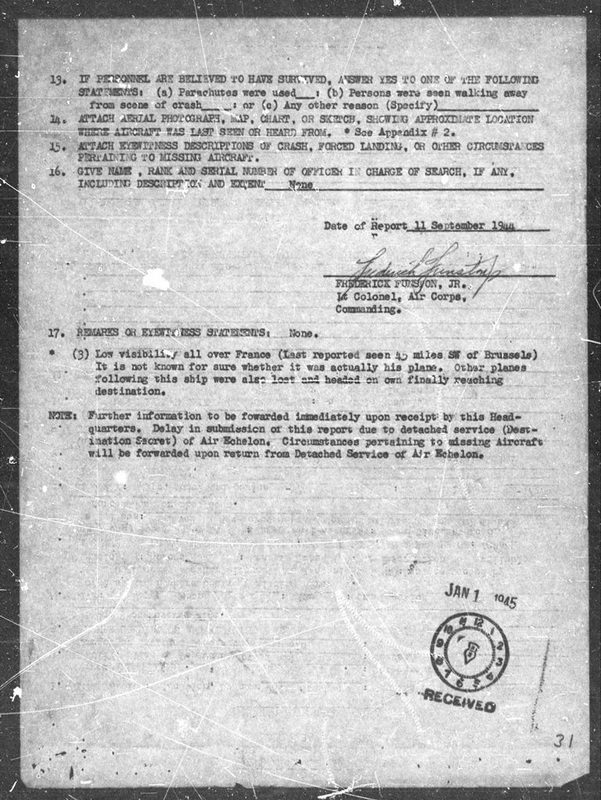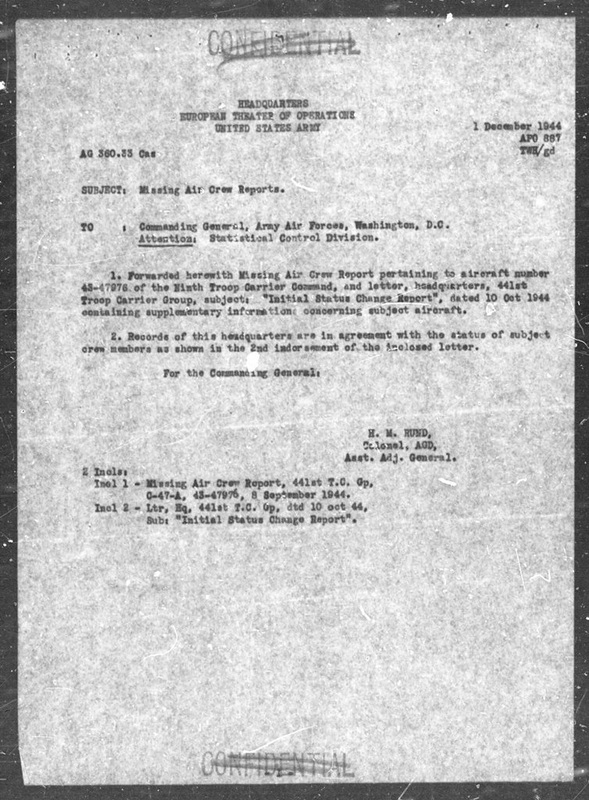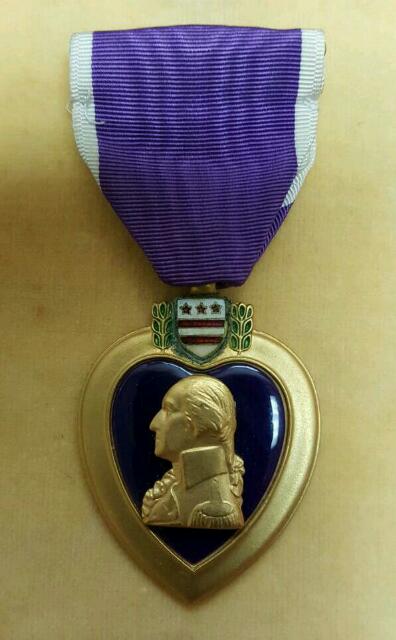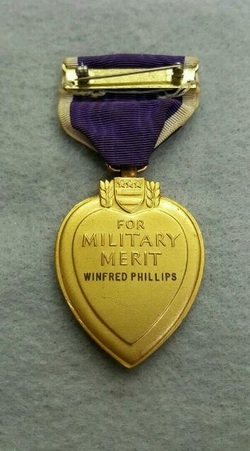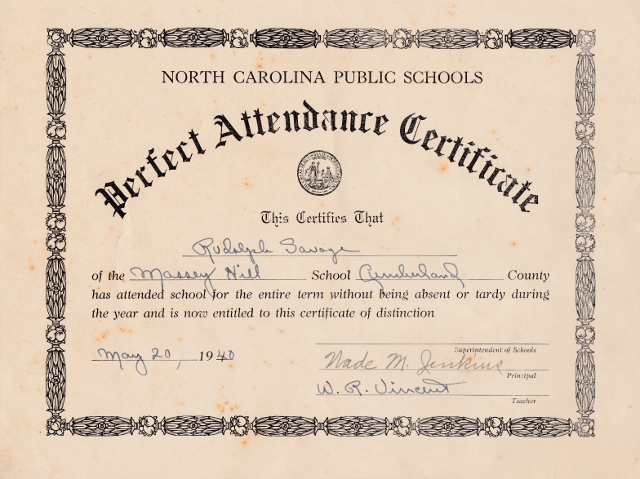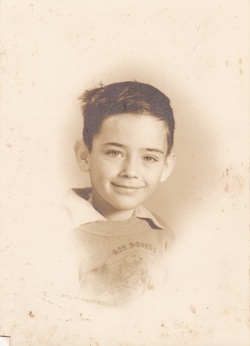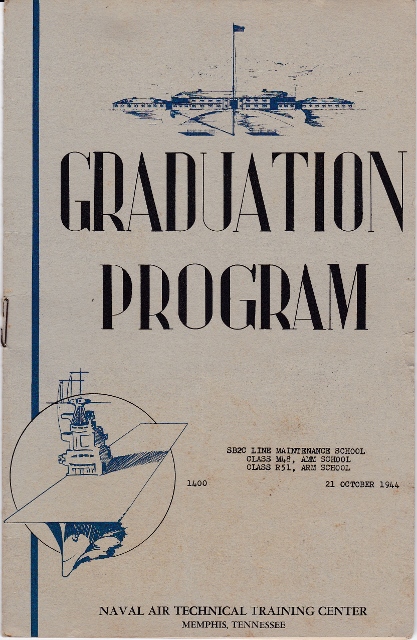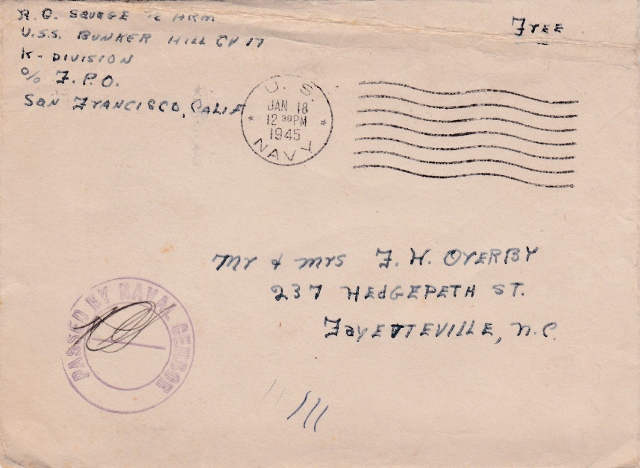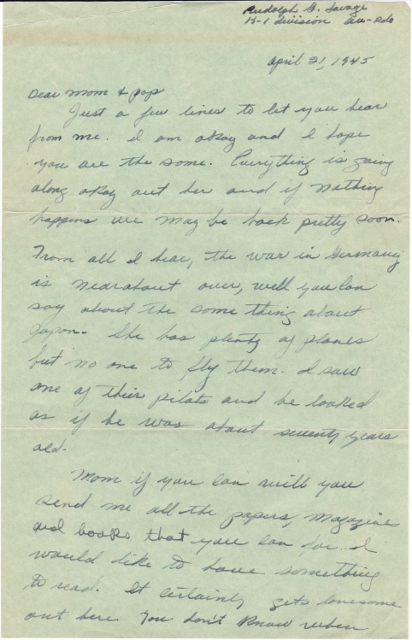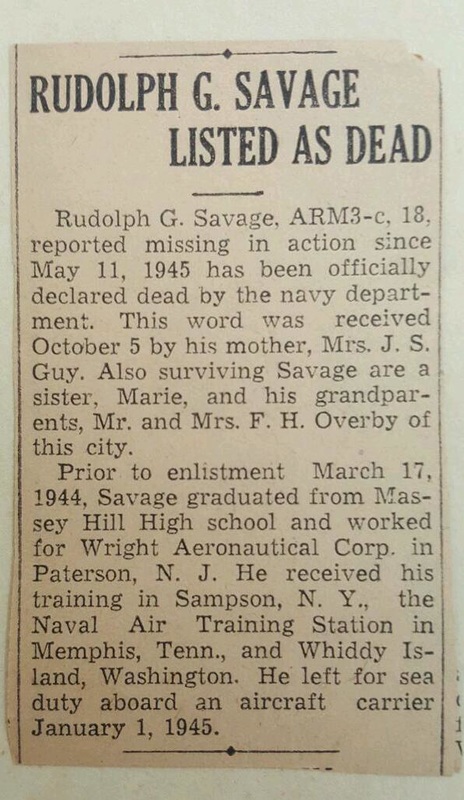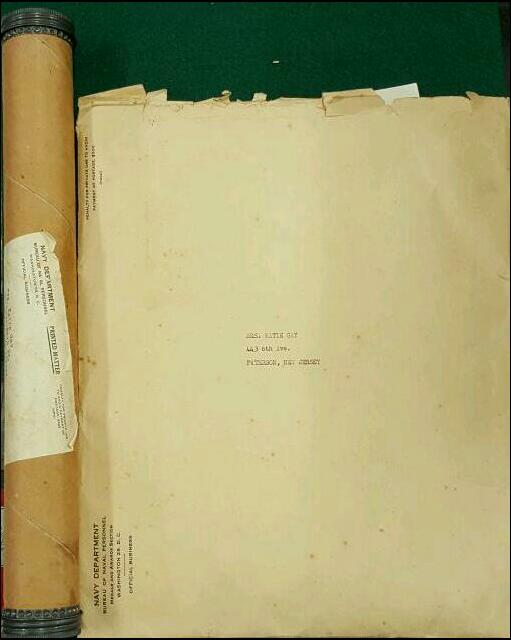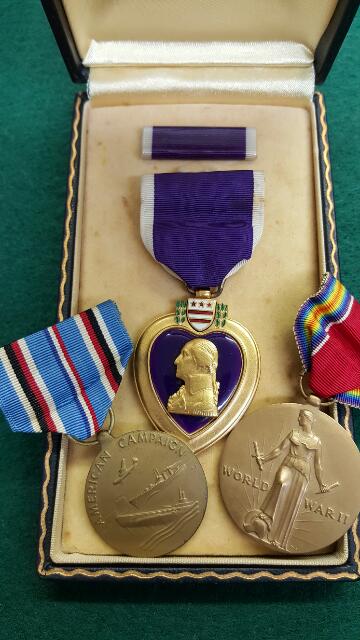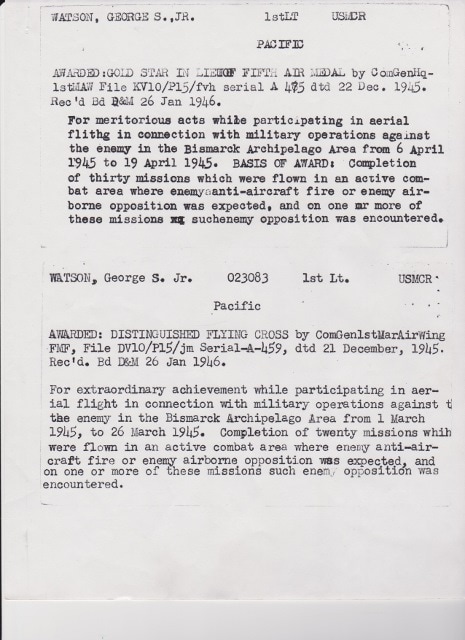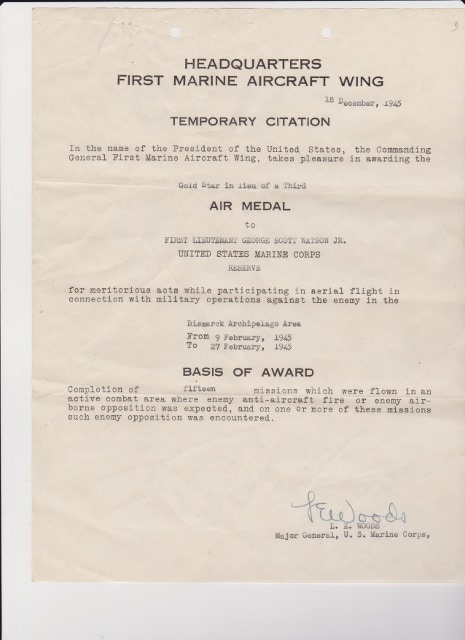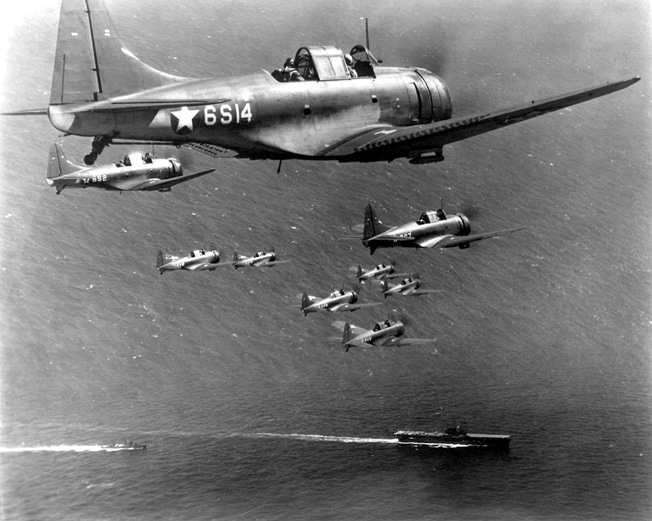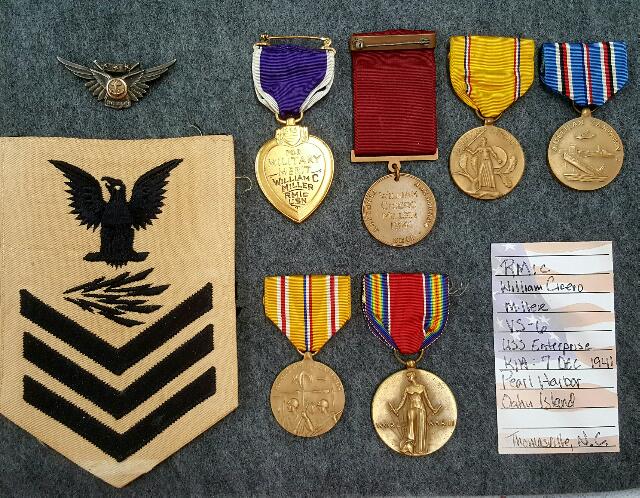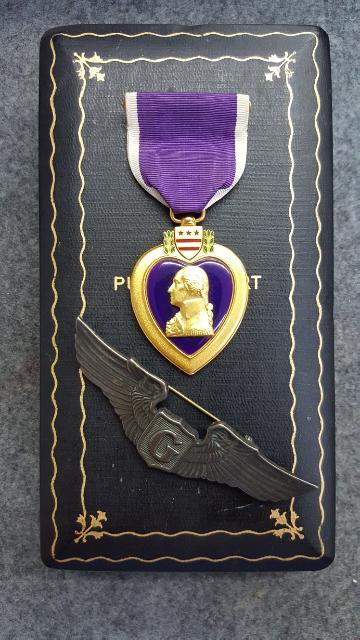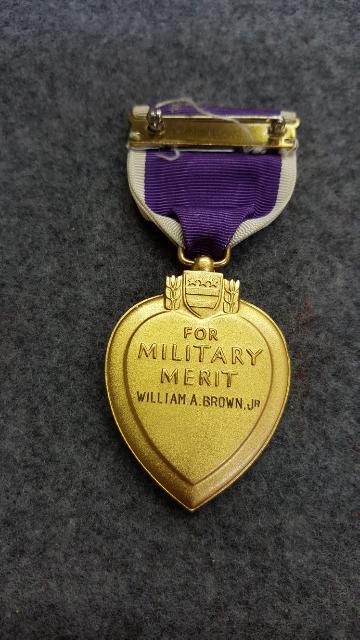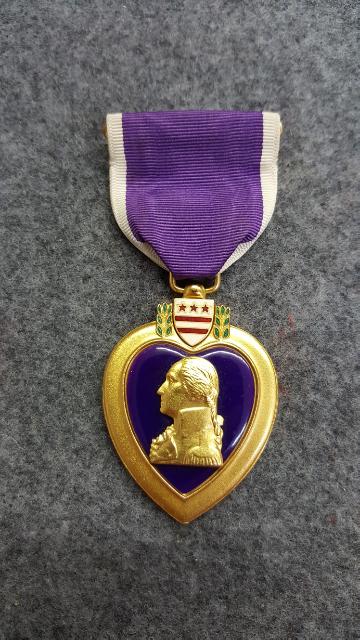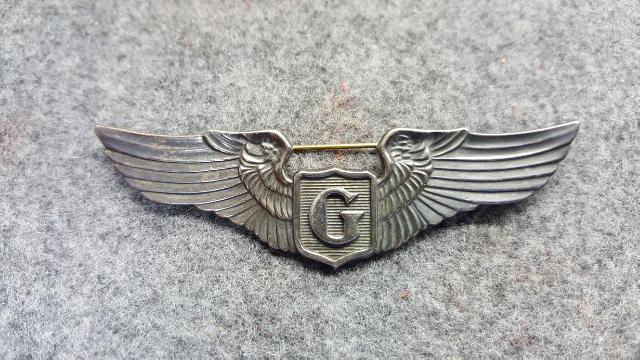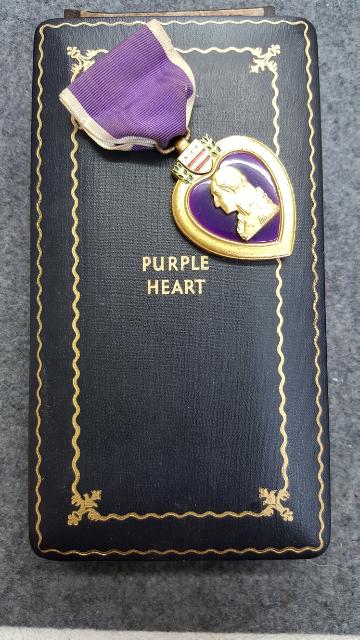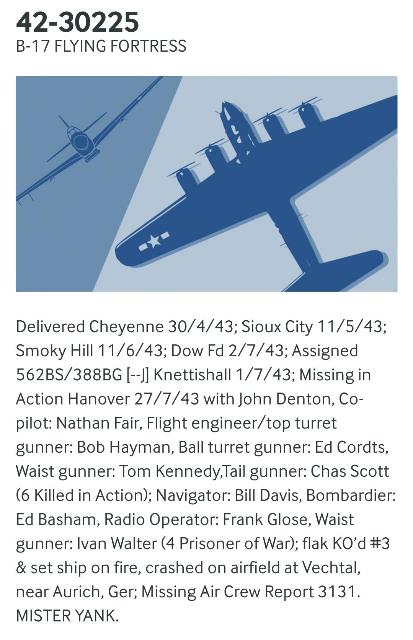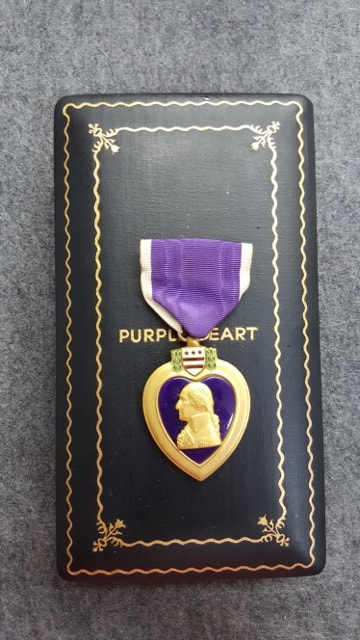This a continuation of the WWII section of Medals
Lt Arthur B Yeates,Jr

Lt Arthur B Yeates, Jr
Birth 20 March 1915
Bath North Carolina
KIA 6 July 1943 on the USS Helena
Birth 20 March 1915
Bath North Carolina
KIA 6 July 1943 on the USS Helena

USS Helena (CL-50) was a St. Louis class light cruiser of the United States Navy. Completed shortly before World War II, she was damaged in the attack on Pearl Harbor, and participated in several battles in the Pacific War. Sunk by a surface-fired torpedo at the battle of Kula Gulf in 1943, she was one of three U.S. light cruisers to be sunk during the war.
Helena was the first US Navy ship to be awarded the Navy Unit Commendation medal.
The war record of this "Helena" has no equal. Damaged at Pearl Harbor on 7 Dec, 1941 she sailed again to action atGuadalcanal, Savo Island, and Cape Esperance where she sank a Japanese cruiser and a destroyer. She was lost in Kula Gulf in 1943 with 165 of her crew. Her survivors call her "the fighting ship that went is harm's way."
Rescue of the crew
Commander Charles Lorain Carpenter, the Helen's navigator (center right with moustache), after being rescued with some other crew members. This was after the cruiser USS Helena was sunk in the Kula Gulf, Solomon Islands. CLC Family image.
Helena's history closes with the almost incredible story of what happened to her men in the hours and days that followed.
Within 30 minutes two destroyers, the Nicholas and Radford were picking up survivors of the Helena. While many of the cruiser's survivors were picked up before morning, many were not saved until 11 days later.
At daylight, the Japanese were in range once more, and again destroyers Nicholas and Radford broke off their rescue operations to pursue. Anticipating an air attack, the destroyers withdrew for Tulagi, carrying with them all but about 275 of the survivors.
To those who remained they left four boats, manned by volunteers from the destroyers' crews collected those in still in the water. Captain Charles Purcell Cecil, Helena's commanding officer, organized a small flotilla of three motor whaleboats, each towing a life raft, carrying 88 men to a small island about 7 miles from Rice Anchorage after a laborious all-day passage. This group was rescued the next morning by destroyers Gwin and Woodworth.
For the second group of nearly 200, the bow of Helena was their life raft, but it was slowly sinking. Disaster was staved off by a Navy PB4Y-1 (B-24) Liberator that dropped lifejackets and four rubber lifeboats. The wounded were placed aboard the lifeboats, while the able-bodied surrounded the boats and did their best to propel themselves toward nearby Kolombangara. But wind and current carried them ever further into enemy waters. Through the torturous day that followed, many of the wounded died. American search planes missed the tragic little fleet, and Kolombangara gradually faded away to leeward. Another night passed, and in the morning the island of Vella Lavella loomed ahead. It seemed the last chance for Helena's men and so they headed for it. By dawn, survivors in all three remaining boats observed land 1 nmi (1.2 mi; 1.9 km) distant and all who were left were safely landed. Two coastwatchers and loyal natives cared for the survivors as best they could, and radioed news of them to Guadalcanal. The 165 remaining crew of the Helena then took to the jungle to evade Japanese patrols.
Surface vessels were chosen for the final rescue, Nicholas and Radford, augmented by Jenkins and O'Bannon set off on 15 July to sail further up the Slot than ever before, screening the movement of two destroyer-transports and four other destroyers. During the night of 16 July, the rescue force brought out the 165 Helena men, along with 16 Chinese who had been in hiding on the island. Of Helena's nearly 900 men, 168 had perished.
Helena was the first US Navy ship to be awarded the Navy Unit Commendation medal.
The war record of this "Helena" has no equal. Damaged at Pearl Harbor on 7 Dec, 1941 she sailed again to action atGuadalcanal, Savo Island, and Cape Esperance where she sank a Japanese cruiser and a destroyer. She was lost in Kula Gulf in 1943 with 165 of her crew. Her survivors call her "the fighting ship that went is harm's way."
Rescue of the crew
Commander Charles Lorain Carpenter, the Helen's navigator (center right with moustache), after being rescued with some other crew members. This was after the cruiser USS Helena was sunk in the Kula Gulf, Solomon Islands. CLC Family image.
Helena's history closes with the almost incredible story of what happened to her men in the hours and days that followed.
Within 30 minutes two destroyers, the Nicholas and Radford were picking up survivors of the Helena. While many of the cruiser's survivors were picked up before morning, many were not saved until 11 days later.
At daylight, the Japanese were in range once more, and again destroyers Nicholas and Radford broke off their rescue operations to pursue. Anticipating an air attack, the destroyers withdrew for Tulagi, carrying with them all but about 275 of the survivors.
To those who remained they left four boats, manned by volunteers from the destroyers' crews collected those in still in the water. Captain Charles Purcell Cecil, Helena's commanding officer, organized a small flotilla of three motor whaleboats, each towing a life raft, carrying 88 men to a small island about 7 miles from Rice Anchorage after a laborious all-day passage. This group was rescued the next morning by destroyers Gwin and Woodworth.
For the second group of nearly 200, the bow of Helena was their life raft, but it was slowly sinking. Disaster was staved off by a Navy PB4Y-1 (B-24) Liberator that dropped lifejackets and four rubber lifeboats. The wounded were placed aboard the lifeboats, while the able-bodied surrounded the boats and did their best to propel themselves toward nearby Kolombangara. But wind and current carried them ever further into enemy waters. Through the torturous day that followed, many of the wounded died. American search planes missed the tragic little fleet, and Kolombangara gradually faded away to leeward. Another night passed, and in the morning the island of Vella Lavella loomed ahead. It seemed the last chance for Helena's men and so they headed for it. By dawn, survivors in all three remaining boats observed land 1 nmi (1.2 mi; 1.9 km) distant and all who were left were safely landed. Two coastwatchers and loyal natives cared for the survivors as best they could, and radioed news of them to Guadalcanal. The 165 remaining crew of the Helena then took to the jungle to evade Japanese patrols.
Surface vessels were chosen for the final rescue, Nicholas and Radford, augmented by Jenkins and O'Bannon set off on 15 July to sail further up the Slot than ever before, screening the movement of two destroyer-transports and four other destroyers. During the night of 16 July, the rescue force brought out the 165 Helena men, along with 16 Chinese who had been in hiding on the island. Of Helena's nearly 900 men, 168 had perished.
S/Sgt John Billie Eldridge
I just picked up this pair of medal groups to a couple of North Carolina boys.While their last names are different...the family relates that Garvey was partially raised by the Eldridge family...so they looked on him as one of the family. John B Eldridge...known as Bill both joined up in WWII...Bill was in Hq company 313th inf...Garvey was in H company 314th inf...both are in the 79th Div.The families of these two men were friends and neighbors.
S/sgt John Billie Eldridge
birth 29 June 1922 Forsyth county North Carolina
death 2 March 1958
Hq co 313th inf regt 79th Div
Twice wounded 11 July 1944 and 3 Jan 1945
Pfc Garvey W Pinnix
birth 29 Sept 1921
Wounded late 1944 in Europe
death 27 July 1945 Kennedy General Hospital Memphis TN
He was at Kennedy Hospital and spent 179 days before dying
of a perforation of the descending colon caused by his wound.
S/sgt John Billie Eldridge
birth 29 June 1922 Forsyth county North Carolina
death 2 March 1958
Hq co 313th inf regt 79th Div
Twice wounded 11 July 1944 and 3 Jan 1945
Pfc Garvey W Pinnix
birth 29 Sept 1921
Wounded late 1944 in Europe
death 27 July 1945 Kennedy General Hospital Memphis TN
He was at Kennedy Hospital and spent 179 days before dying
of a perforation of the descending colon caused by his wound.
Pfc Garvey W Pinnix

Garvey and Bill

Garvey
Pfc Lemuel K Davis

Pfc Lemuel K Davis
service# 34595806
Battery A
493rd Field Artillery
12th Armored Div
KIA 28 March 1945
Birth 31 March 1922
Valle Crusis North Carolina
service# 34595806
Battery A
493rd Field Artillery
12th Armored Div
KIA 28 March 1945
Birth 31 March 1922
Valle Crusis North Carolina
Pfc Claude Baker,Jr

Pfc Claude Baker,Jr
service# 34433826
Birth: 3 June 1922 Leicester,North Carolina
KIA: 12 July 1944
28th inf regt
8th Inf Div
Landed on Utah Beach 4 July 1944
service# 34433826
Birth: 3 June 1922 Leicester,North Carolina
KIA: 12 July 1944
28th inf regt
8th Inf Div
Landed on Utah Beach 4 July 1944
Pvt Pink Morgan
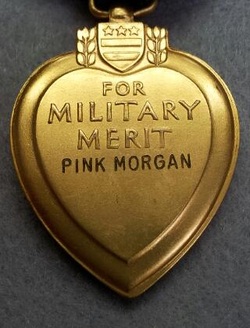
Pvt Pink Morgan
service# 14030319
Birth: 27 Oct 1919 Norwood North Carolina
KIA: 7 Jan 1945
Co A 83rd Armored Recon Cavalry
3rd Armred Div "Spearhead"
"Task Force Hogan" & "400 at Marcouray"
83rd. ARMD. RECON BN "OSGOOD"
The 83rd Armored Reconnaissance Battalion is an original "Spearhead" unit, On May 12,1941, the then 3rd Reconnaissance became the 83rd Armored Reconnaissance Battalion. As such it made history in the five western European campaigns of World War II.Four officers commanded the 83rd in combat. They were Lt. Colonel William L. Cabaniss, who led the organization in Normandy and was transferred late in August; Major John R. Tucker, Jr., who then assumed command. became executive officer upon the assignment of Lt. Colonel Prentice E. Yeomans, two weeks later. Colonel Yeomans commanded the battalion through most of its great triumphs on the battlefield and was himself killed in action during the last weeks of the war. Major Richard L. Bradley then assumed command.Under the leather lunged and capable Colonel Yeomans, the 83rd came into its own as a great fighting force. With Combat Command "B", the battalion was among the first Americans to reach German soil in force. The 83rd also occupied Roetgen, on September 12, 1944, the first German town to fall to allied troops. During the bitter winter campaign in Belgium, the battalion was again in the limelight. Company "A" was with Task Force Hogan's "400" at 'Marcouray: personnel of the unit reconnoitering a route out of that death trap and leading a 14 hour march through German lines on Christmas night. Later, the company, along with the rest of the battalion, spearheaded an attack which cut the vital St. Vith-Houffalize road.Back in Germany for the last great offensive early in 1945, the 83rd Armored Reconnaissance Battalion again led the "Spearhead" in several of its most notable drives. The battalion was the first unit of the First Army to reach the Rhine, touching the "sacred river" at 4 A. M. on March 4, north of Worringen. In the magnificent Paderborn sweep to encircle the industrial Ruhi, Colonel Yeoman's men again whipped out in front to lead the entire division on the longest armored drive ever made in the history of warfare, 90 road miles against opposition. During the last days of the war in the west, Lt. Colonel Yeomans was killed in action while leading his troops in the town of Zschepkau on the approaches to Dessau. Major Richard L. Bradley then assumed command
service# 14030319
Birth: 27 Oct 1919 Norwood North Carolina
KIA: 7 Jan 1945
Co A 83rd Armored Recon Cavalry
3rd Armred Div "Spearhead"
"Task Force Hogan" & "400 at Marcouray"
83rd. ARMD. RECON BN "OSGOOD"
The 83rd Armored Reconnaissance Battalion is an original "Spearhead" unit, On May 12,1941, the then 3rd Reconnaissance became the 83rd Armored Reconnaissance Battalion. As such it made history in the five western European campaigns of World War II.Four officers commanded the 83rd in combat. They were Lt. Colonel William L. Cabaniss, who led the organization in Normandy and was transferred late in August; Major John R. Tucker, Jr., who then assumed command. became executive officer upon the assignment of Lt. Colonel Prentice E. Yeomans, two weeks later. Colonel Yeomans commanded the battalion through most of its great triumphs on the battlefield and was himself killed in action during the last weeks of the war. Major Richard L. Bradley then assumed command.Under the leather lunged and capable Colonel Yeomans, the 83rd came into its own as a great fighting force. With Combat Command "B", the battalion was among the first Americans to reach German soil in force. The 83rd also occupied Roetgen, on September 12, 1944, the first German town to fall to allied troops. During the bitter winter campaign in Belgium, the battalion was again in the limelight. Company "A" was with Task Force Hogan's "400" at 'Marcouray: personnel of the unit reconnoitering a route out of that death trap and leading a 14 hour march through German lines on Christmas night. Later, the company, along with the rest of the battalion, spearheaded an attack which cut the vital St. Vith-Houffalize road.Back in Germany for the last great offensive early in 1945, the 83rd Armored Reconnaissance Battalion again led the "Spearhead" in several of its most notable drives. The battalion was the first unit of the First Army to reach the Rhine, touching the "sacred river" at 4 A. M. on March 4, north of Worringen. In the magnificent Paderborn sweep to encircle the industrial Ruhi, Colonel Yeoman's men again whipped out in front to lead the entire division on the longest armored drive ever made in the history of warfare, 90 road miles against opposition. During the last days of the war in the west, Lt. Colonel Yeomans was killed in action while leading his troops in the town of Zschepkau on the approaches to Dessau. Major Richard L. Bradley then assumed command
Pfc Edgar B Smith Jr
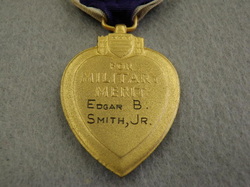
Pfc Edgar B Smith Jr
Birth 28 April 28 1922
Bladen Co North Carolina
KIA 21 Dec 1944
Pacific
306th inf regt
77th Division
The 77th Infantry Division landed in Hawaii, 31 March 1944, and continued training in amphibious and jungle warfare. Elements began to leave Hawaii, 1 July 1944, for the amphibious assault on Guam. Attached to III Amphibious Force, the 77th made an assault landing on Guam, 21 July 1944. After taking over defense of the beachhead, the Division drove north to seize Mount Tenjo and effected junction with the 3d Marine Division, linking the northern and southern bridgeheads, 23-29 July. It continued to drive north, and dislodged the enemy from positions at Barrigada town and mountain, 4 August, resistance ending on the 8th. With Guam recaptured, the 77th sailed for New Caledonia, but plans were changed en route and it was directed to proceed to Leyte. The Division landed on the east coast of Leyte, 23 November 1944, and was attached to XXIV Corps, Sixth Army. After a short period of training and combat patrolling in the Corps' rear, 23 November-6 December, it landed at Ipil and fought up the east coast of Ormoc Bay to seize Ormoc, 10 December. Attacking north, astride Highway No. 2, the Division secured Valencia and the Libungao-Palompon road junction. Mopping up operations continued through January 1945 to 5 February 1945. The next combat assignment was Okinawa. In late March (26-29), the Division made 15 landings, securing Kerama Retto and Keise Shima for the assault on Okinawa. Riding at sea, 1-15 April 1945, it suffered casualties from enemy suicide attacks, - and prepared for the assault landing on Ie Shima. On 16 April 1945, the 77th landed on le Shims, captured the airfield, and engaged in a bitter fight for "Government House Hill" and "Bloody Ridge." It was in this operation that Ernie Pyle was killed. On 25 April, it left le Shims for Okinawa, relieving the 96th Division, 28 April 1945. Fighting its way slowly against extremely heavy Japanese resistance, the Division, drove to Shuri in conjunction with the 1st Marine Division, occupying it 29-31 May. In June the Division covered the right flank of XXIV Corps and "sealed" Japanese cave positions. In July the Division moved to Cebu, Philippine Islands, and prepared for. the invasion (later occupation) of Japan. The Division landed in Japan in October 1945 for occupation duty, and was inactivated a few months later, 15 March 1946.
Birth 28 April 28 1922
Bladen Co North Carolina
KIA 21 Dec 1944
Pacific
306th inf regt
77th Division
The 77th Infantry Division landed in Hawaii, 31 March 1944, and continued training in amphibious and jungle warfare. Elements began to leave Hawaii, 1 July 1944, for the amphibious assault on Guam. Attached to III Amphibious Force, the 77th made an assault landing on Guam, 21 July 1944. After taking over defense of the beachhead, the Division drove north to seize Mount Tenjo and effected junction with the 3d Marine Division, linking the northern and southern bridgeheads, 23-29 July. It continued to drive north, and dislodged the enemy from positions at Barrigada town and mountain, 4 August, resistance ending on the 8th. With Guam recaptured, the 77th sailed for New Caledonia, but plans were changed en route and it was directed to proceed to Leyte. The Division landed on the east coast of Leyte, 23 November 1944, and was attached to XXIV Corps, Sixth Army. After a short period of training and combat patrolling in the Corps' rear, 23 November-6 December, it landed at Ipil and fought up the east coast of Ormoc Bay to seize Ormoc, 10 December. Attacking north, astride Highway No. 2, the Division secured Valencia and the Libungao-Palompon road junction. Mopping up operations continued through January 1945 to 5 February 1945. The next combat assignment was Okinawa. In late March (26-29), the Division made 15 landings, securing Kerama Retto and Keise Shima for the assault on Okinawa. Riding at sea, 1-15 April 1945, it suffered casualties from enemy suicide attacks, - and prepared for the assault landing on Ie Shima. On 16 April 1945, the 77th landed on le Shims, captured the airfield, and engaged in a bitter fight for "Government House Hill" and "Bloody Ridge." It was in this operation that Ernie Pyle was killed. On 25 April, it left le Shims for Okinawa, relieving the 96th Division, 28 April 1945. Fighting its way slowly against extremely heavy Japanese resistance, the Division, drove to Shuri in conjunction with the 1st Marine Division, occupying it 29-31 May. In June the Division covered the right flank of XXIV Corps and "sealed" Japanese cave positions. In July the Division moved to Cebu, Philippine Islands, and prepared for. the invasion (later occupation) of Japan. The Division landed in Japan in October 1945 for occupation duty, and was inactivated a few months later, 15 March 1946.
S/Sgt Roy H Austin
S/Sgt Roy H Austin
DOB 24 Sept 1921 Beaufort North Carolina
Entered the Service 28 July 1942
Service # 34313340
2nd Platoon... D Co
506th Parachute Infantry Regiment
101st Airborne Division
A orginial Toccoa man
S/Sgt Austin's fight began June 6 1944 Normandy as a member of 2nd Platoon 2nd Squad Stick 63 jumping in from Plane # 42-100846 on D-Day He fought there for five weeks
S/Sgt Austin parachuted in near Eindhoven Holland and fought for seventy days
KIA on 15 Jan 1945 at Norville Belgium leading a frontal assault on machine gun emplacements
S/Sgt Austin was awarded a Silver Star for his actions that day on the assault on Norville
DOB 24 Sept 1921 Beaufort North Carolina
Entered the Service 28 July 1942
Service # 34313340
2nd Platoon... D Co
506th Parachute Infantry Regiment
101st Airborne Division
A orginial Toccoa man
S/Sgt Austin's fight began June 6 1944 Normandy as a member of 2nd Platoon 2nd Squad Stick 63 jumping in from Plane # 42-100846 on D-Day He fought there for five weeks
S/Sgt Austin parachuted in near Eindhoven Holland and fought for seventy days
KIA on 15 Jan 1945 at Norville Belgium leading a frontal assault on machine gun emplacements
S/Sgt Austin was awarded a Silver Star for his actions that day on the assault on Norville
Private Kelly W Byars
Private Kelly W Byars
serial# 34116290
A Co
505th Parachute Infantry Regiment
82nd Airborne Division
Birth: Salisbury, North Carolina
Awarded the Silver Star for gallantry for actions on 20 Sept 1944 Holland
serial# 34116290
A Co
505th Parachute Infantry Regiment
82nd Airborne Division
Birth: Salisbury, North Carolina
Awarded the Silver Star for gallantry for actions on 20 Sept 1944 Holland
F1c Lewis M King
F1c Lewis Meyer King
serial# 2623778
Birth: North Carolina
USS Arizona BB-39
KIA 7 December 1941
Pearl Harbor Hawaii
serial# 2623778
Birth: North Carolina
USS Arizona BB-39
KIA 7 December 1941
Pearl Harbor Hawaii
Pfc James E Martin
Pfc James E Martin
Birth: 26 July 1912 Davidson Co. North Carolina
317th Infantry Regiment Anti-Tank
80th Infantry Division
KIA: 25 Jan 1945
Birth: 26 July 1912 Davidson Co. North Carolina
317th Infantry Regiment Anti-Tank
80th Infantry Division
KIA: 25 Jan 1945
Pfc Palmer W Helton
Palmer Worth Helton had been born on November 6,1916 in Gastonia, North Carolina. He married his childhood sweetheart Ruby Stewart. ..they had a son and his name was Calvin "Dump"Helton.
Palmer wrote to his family quite often professing his love and homesickness. He asked in every letter that his and her family pray for his safety and return to them...
Pvt.Palmer Worth Helton
service ##34893494
Co.D 36th Armored Infantry Regiment
KIA. ..17 September 1944
Palmer W Helton
A stack of sadness
Ruby wrote this in honor of Palmer
Palmer's last letter home
A Hero comes Home...Bless him
Cpl Robert E Cagle
Cpl Robert E Cagle
Birth : 8 May 1922...Guilford County,North Carolina
service# 34466942
175th Infantry Regt.
29th Infantry Division
KIA 16 July 1944
Normandy,France
TM3c Lloyd Sheets
I just picked up this Purple Heart to a North Carolina Sailor.
TM3C Lloyd Sheets from Reddies River, North Carolina
TM3c Sheets was lost aboard the USS Monssen. ..sunk by surface fire at the Naval Battle of Guadalcanal on 13 January 1945
The USS Monssen still rests at the bottom of "Iron Bottom Sound". It was located by Robert Ballard in 1992.
"Fair Winds and Following Seas
TM3C Lloyd Sheets from Reddies River, North Carolina
TM3c Sheets was lost aboard the USS Monssen. ..sunk by surface fire at the Naval Battle of Guadalcanal on 13 January 1945
The USS Monssen still rests at the bottom of "Iron Bottom Sound". It was located by Robert Ballard in 1992.
"Fair Winds and Following Seas
After Midway the force remained at Pearl Harbor for a month before departing again for combat. Steaming via the Tonga Islands, they headed for the Japanese heldSolomons. By 7 August they were 40 miles from the targets, Guadalcanal and Tulagi. On the 7th and 8th, Monssen with Buchanan (DD-484) stood off Gavutu andTanambogo, circling those islands and providing fire support to units of the 2nd Marine Regiment as the U.S. Navy struck with the first of its giant amphibious assaults. She was then assigned to the screening forces guarding the eastern approaches to Sealark, Lengo, and Nggela Channels.
She remained in the immediate area through the Battle of the Eastern Solomons, which prevented Japanese reinforcements from reaching Guadalcanal, and then took up duties patrolling the sea routes to Guadalcanal. At the end of the month Saratoga(CV-3) was damaged and Monssen was one of the ships designated to escort her to the Tonga Islands.
Sinking at the Naval Battle of Guadalcanal
Monssen returned to Guadalcanal 18 September to insure the integrity of an Allied supply line and to block Japanese efforts at resupply. On 8 November, she departed Nouméa with two cruisers and two other destroyers as Task Group 67.4 (TG 67.4), under Rear Admiral Daniel J. Callaghan, as escort for transports carrying reinforcements to the marines on Guadalcanal. At the same time, another convoy set out from Espiritu Santo, covered by one cruiser and four destroyers under Rear Admiral Norman Scott. Arriving off Lunga Point on the 12th, a day after those from Espiritu Santo they commenced unloading. By dusk as reports of Japanese ship movements from Truk increased, 90 percent of the transports had been unladen despite afternoon torpedo plane attacks, one of which had cost Monssen the use of her fire control radar. The transports were pulled out, escorted through Lengo Channel, and seen safely on their way to Espiritu Santo. Then Admiral Callaghan's force, heavily outnumbered even with the addition of Admiral Scott's ships, reversed course and steamed back to engage the enemy in the initial action of what would later be called the Naval Battle of Guadalcanal.
Shortly, after 01:40, 13 November, they sighted the enemy fleet, under Vice AdmiralHiroaki Abe, 3 miles north of Kukum. The enemy was headed toward Henderson Field to bombard it and cripple Allied air operations long enough to sneak in 11 of their transports, then en route to relieve their beleaguered comrades fighting on the island.
Battle was given at 01:50. At about 02:20 Monssen, forced to rely on radio information and optics, was spotlighted, hit by some 39 shells, including 3 of battleship caliber, and reduced to a burning hulk.[1] Twenty minutes later, completely immobilized in all departments, the ship was ordered abandoned. After daybreak Monssen was still a floating incinerator. C. C. Storey, BM2c, L. F. Sturgeon, GM2c, and J. G. Hughes F1c, climbed back into the inferno and rescued eight men still aboard and alive, five of whom lived after reaching land. The survivors, 40 percent of the crew, were picked up at about 08:00 and taken to Guadalcanal. The ship herself continued to blaze until early afternoon, when the waters of Ironbottom Sound closed over her.
Monssen was awarded four battle stars for World War II service.
She remained in the immediate area through the Battle of the Eastern Solomons, which prevented Japanese reinforcements from reaching Guadalcanal, and then took up duties patrolling the sea routes to Guadalcanal. At the end of the month Saratoga(CV-3) was damaged and Monssen was one of the ships designated to escort her to the Tonga Islands.
Sinking at the Naval Battle of Guadalcanal
Monssen returned to Guadalcanal 18 September to insure the integrity of an Allied supply line and to block Japanese efforts at resupply. On 8 November, she departed Nouméa with two cruisers and two other destroyers as Task Group 67.4 (TG 67.4), under Rear Admiral Daniel J. Callaghan, as escort for transports carrying reinforcements to the marines on Guadalcanal. At the same time, another convoy set out from Espiritu Santo, covered by one cruiser and four destroyers under Rear Admiral Norman Scott. Arriving off Lunga Point on the 12th, a day after those from Espiritu Santo they commenced unloading. By dusk as reports of Japanese ship movements from Truk increased, 90 percent of the transports had been unladen despite afternoon torpedo plane attacks, one of which had cost Monssen the use of her fire control radar. The transports were pulled out, escorted through Lengo Channel, and seen safely on their way to Espiritu Santo. Then Admiral Callaghan's force, heavily outnumbered even with the addition of Admiral Scott's ships, reversed course and steamed back to engage the enemy in the initial action of what would later be called the Naval Battle of Guadalcanal.
Shortly, after 01:40, 13 November, they sighted the enemy fleet, under Vice AdmiralHiroaki Abe, 3 miles north of Kukum. The enemy was headed toward Henderson Field to bombard it and cripple Allied air operations long enough to sneak in 11 of their transports, then en route to relieve their beleaguered comrades fighting on the island.
Battle was given at 01:50. At about 02:20 Monssen, forced to rely on radio information and optics, was spotlighted, hit by some 39 shells, including 3 of battleship caliber, and reduced to a burning hulk.[1] Twenty minutes later, completely immobilized in all departments, the ship was ordered abandoned. After daybreak Monssen was still a floating incinerator. C. C. Storey, BM2c, L. F. Sturgeon, GM2c, and J. G. Hughes F1c, climbed back into the inferno and rescued eight men still aboard and alive, five of whom lived after reaching land. The survivors, 40 percent of the crew, were picked up at about 08:00 and taken to Guadalcanal. The ship herself continued to blaze until early afternoon, when the waters of Ironbottom Sound closed over her.
Monssen was awarded four battle stars for World War II service.
Wreck discovery
In 1992, an expedition headed by oceanographer Robert Ballard found the wreck ofMonssen and other ships sunk during the Solomon Islands battles. The wreck lies upright on the bottom of the sound, with the gun turrets still trained out to the starboard side as they had been in combat.
Pfc Willie H Bouldin
Pfc Willie H Bouldin
Coleridge, NC
Birth...5 August 1922
61st Armored Infantry Regiment
10th Armored Division
KIA. ..22 November 1944
Randolph County. ..
Coleridge, NC
Birth...5 August 1922
61st Armored Infantry Regiment
10th Armored Division
KIA. ..22 November 1944
Randolph County. ..
Flight Officer Marshall A Rockett,Jr
Flight Officer Marshall A Rockett, Jr
Conover, North Carolina
Birth...10 December 1918
Co-Pilot...C-47 Skytrain
302nd AAF Troop Carrier Squadron
KIA. ..7 September 1944 Belgium
Catawba County. ..
Conover, North Carolina
Birth...10 December 1918
Co-Pilot...C-47 Skytrain
302nd AAF Troop Carrier Squadron
KIA. ..7 September 1944 Belgium
Catawba County. ..
Pvt Robert R Mangum
Pvt Robert R Mangum was born 15 November 1922 in Glen Alpine,Burke County, North Carolina.He orginally suffered a wound on 17 May1944 in Italy.His parents received a letter from Robert telling of his recovery and soon to be back on duty status.
In a 26 June letter to his mother after leaving the hospital, Mangum relays his sound condition and being nearly well.Then he wrote of his duties...''My Job,'' he said, ''Is to handle the light machine gun.It talks English the Germans understand.''
Pvt Robert R Mangum serving with the 337th Infantry Regiment of the 85th Division, was Killed in Action on 27 Oct 1944...Italy.
''If ye break faith with us who die,We shall not sleep''.
In a 26 June letter to his mother after leaving the hospital, Mangum relays his sound condition and being nearly well.Then he wrote of his duties...''My Job,'' he said, ''Is to handle the light machine gun.It talks English the Germans understand.''
Pvt Robert R Mangum serving with the 337th Infantry Regiment of the 85th Division, was Killed in Action on 27 Oct 1944...Italy.
''If ye break faith with us who die,We shall not sleep''.
Alpheus W White
Birth...19 September 1905... Vance County North Carolina
KIA. ..7 June 1944 Burma
B Co 236th Combat Engineer Battalion...Armor Service...
Then 5307th Composite Unit...Merrill's Marauders..."New Galahad"
"An God said who shall we send.I answered I am here,send me.
Birth...19 September 1905... Vance County North Carolina
KIA. ..7 June 1944 Burma
B Co 236th Combat Engineer Battalion...Armor Service...
Then 5307th Composite Unit...Merrill's Marauders..."New Galahad"
"An God said who shall we send.I answered I am here,send me.
WWII. ..
The 236th was created during World War II, an offspring of the 44th Engineer Combat Regiment at Camp McCoy, Wisconsin. After practicing maneuvers in Tennessee in 1943, the 236th was deployed to the China-Burma-India Theater, where they started work on the Ledo Road - a necessary supply route through harsh jungle terrain at the base of the Himalayan Mountains, and on the edge of Japanese-occupied territory.
Work on the Ledo Road was halted by a Japanese Garrison, in the town of Myitkyina. Gen. Stillwell, chief commander of the China-Burma-India Theater, had tried to dislodge the Japanese from Myitkyina in mid May, 1944. He succeeded in taking a nearby airstrip, but was repelled from the town by unexpectedly strong Japanese defenses.
With a force already weakened from fatigue, disease and wounds, Stillwell called up the 236th to the front lines. Men who had been used to driving trucks and operating heavy equipment were suddenly picking up a rifle and heading into battle.
The Japanese managed to assemble nearly 2,500 soldiers in Myitkyina in the final days of May, 1944 to engage the 236th and another battalion of combat engineers, the 209th. The battle for Myitkyina raged for two months and the engineers, fighting alongside poorly trained Chinese soldiers, bore the brunt of the Japanese forces, defending against infantry attacks as well as artillery and mortar fire.
The battle resulted in victory for the Allies, but at a heavy price: 56 killed in action and another 142 wounded from the 236th alone. One of these casualties was Sgt. Fred Coleman, who threw himself on a grenade in order to save the lives of two of his comrades.
The members of the 236th distinguished themselves in the battle for Myitkyina and earned the praise of their commanders. Stillwell himself was impressed with their performance since many of them had not picked up a rifle since basic training. Both battalions received the Presidential Unit Citation for their valiant efforts in battle.
The 209th and 236th Engineer Combat
Battalion fought at Myitkyina as part of
the 5307th under command of Colonel
Hunt
Pfc Winfred Phillips
Pfc Winfred Phillips
DOB...30 August 1916 Haywood County North Carolina
Serial # 34772505
309th Combat Engineer Battalion 84th Division
KIA. ..2 May 1945
Pfc Winfred Phillips enlisted at Camp Croft, South Carolina.
Pfc Winfred Phillips was a chauffeur before he enlisted.
Private First Class Winfred Phillips, who was serving with the 309th Engineers of the 9th Army was killed in action in Germany on May 2.
Pfc Phillips entered the service on April 12, 1943, and was inducted at Camp Croft and from there transferred to Fort Belvoir, Va. He was sent overseas in July, 1943, and had served in France, Belgium, and Germany. He had been wounded twice. At the time he entered the service he was employed by the U.S. Engineers in Norfolk, Va
DOB...30 August 1916 Haywood County North Carolina
Serial # 34772505
309th Combat Engineer Battalion 84th Division
KIA. ..2 May 1945
Pfc Winfred Phillips enlisted at Camp Croft, South Carolina.
Pfc Winfred Phillips was a chauffeur before he enlisted.
Private First Class Winfred Phillips, who was serving with the 309th Engineers of the 9th Army was killed in action in Germany on May 2.
Pfc Phillips entered the service on April 12, 1943, and was inducted at Camp Croft and from there transferred to Fort Belvoir, Va. He was sent overseas in July, 1943, and had served in France, Belgium, and Germany. He had been wounded twice. At the time he entered the service he was employed by the U.S. Engineers in Norfolk, Va
Some Internet information about the Division. Pfc Phillips was killed the day the 84th made contact with the Russians.
The 84th Infantry Division was activated on 15 October 1942. It embarked on 20 September 1944 and arrived in the United Kingdom on 1 October, for additional training. The division landed on Omaha Beach, 14 November 1944, and moved to the vicinity of Gulpen, the Netherlands, 512 November. The division entered combat, 18 November, with an attack on Geilenkirchen, Germany, as part of the larger offensive in the Roer Valley, north of Aachen. Taking Geilenkirchen, as part of Operation Clipper on 19 November, the division pushed forward to take Beeck (Geilenkirchen) and Lindern in the face of heavy enemy resistance, 29 November.[3] After a short rest, the division returned to the fight, taking Wurm and Würm (Geilenkirchen), Mullendorf, 18 December, before moving to Belgium to help stem the German winter offensive (Battle of the Bulge).
Battling in snow, sleet, and rain, the division threw off German attacks, recaptured Verdenne, 2428 December, took Beffe and Devantave, 46 January 1945, and seized Laroche, 11 January. By 16 January, the Bulge had been reduced. After a 5-day respite, the 84th resumed the offensive, taking Gouvy and Beho. On 7 February, the division assumed responsibility for the Roer River zone, between Linnich and Himmerich (near Heinsberg), and trained for the river crossing.
On 23 February 1945, the second day of Operation Grenade, the division cut across the Roer, took Boisheim and Dülken, 1 March, crossed the Niers on 2 March, took Krefeld, 3 March, and reached the Rhine by 5 March. One day before, the 'Krefeld-Uerdinger Brücke' was blown off by Wehrmacht soldiers.[4] The division trained along the west bank of the river in March.
After crossing the Rhine, 1 April, the division drove from Lembeck toward Bielefeld in conjunction with the 5th Armored Division, crossing the Weser River to capture Hanover, 10 April. By 13 April, it had reached the Elbe, and halted its advance, patrolling along the river. The Russians were contacted at Balow, 2 May 1945. The division remained on occupation duty in Germany after VE-day, returning to the United States on 19 January 1946 for demobilization. It was redesignated a reserve formation on 21 January 1946
The 84th Division's involvement with concentration camps.
In World War II, the "Railsplitter" division landed on Omaha Beach in Normandy in early November 1944, five months after D-Day (June 6, 1944). From France, the unit moved quickly into the Netherlands in preparation for an offensive into Nazi Germany. During the Battle of the Bulge, the 84th was diverted to Belgium to stop the German offensive. In March 1945, it moved into the Rhineland and subsequently advanced northward, capturing the city of Hannover on April 10. The 84th eventually made its way to the Elbe River and made contact with Soviet armed forces in early May 1945.
As the "Railsplitter" division advanced into the interior of Germany, its troops uncovered Hannover-Ahlem (April 10, 1945) and Salzwedel (April 14, 1945), both satellite camps of the Neuengamme concentration camp. The SS established the Hannover-Ahlem camp on November 30, 1944, after transferring the camp and its inmates from the Continental Gummiwerke factory at Hannover-Stöcken. In Ahlem the inmates were forced to work in the nearby asphalt tunnels. These were to be cleared for the production of aircraft and Panzer parts for Continental Gummiwerke and Maschinenfabrik Hannover.
When the soldiers of the 84th entered the camp in Ahlem, they discovered an undetermined number of starving and ill Jewish prisoners. Reports range from 30 to 250 persons. The SS guards had abandoned these prisoners when they evacuated the camp, taking with them some 600 "healthy" prisoners. Of the prisoners sent on this death march, only 450 made it to the Bergen-Belsen camp. The SS guards had shot many of those who were unable to maintain the pace of the march. The US Army war crimes investigators reported that many of these survivors died soon after liberation from the accumulated abuse, mistreatment, and neglect they had suffered. They estimated that only 300 to 400 Jewish prisoners at Hannover-Ahlem survived the war.
Several days later, the 84th Infantry captured Salzwedel, a camp formed by the SS in July 1944 to supply forced labor for a German munitions factory. The unit found some 3,000 female inmates, mainly Jewish women who had been transported from the Auschwitz camp complex, and several hundred political prisoners. The US Army reported that sanitary conditions at the camp were poor because of overcrowding and a lack of water. Some 100 of these prisoners were seriously ill and 33 of them required immediate medical attention at a local hospital. The town's mayor was ordered to provide food immediately for the former inmates, who were subsequently moved into modern German barracks nearby.
The 84th Infantry Division was recognized as a liberating unit by the US Army's Center of Military History and the United States Holocaust Memorial Museum in 1993
The 84th Infantry Division was activated on 15 October 1942. It embarked on 20 September 1944 and arrived in the United Kingdom on 1 October, for additional training. The division landed on Omaha Beach, 14 November 1944, and moved to the vicinity of Gulpen, the Netherlands, 512 November. The division entered combat, 18 November, with an attack on Geilenkirchen, Germany, as part of the larger offensive in the Roer Valley, north of Aachen. Taking Geilenkirchen, as part of Operation Clipper on 19 November, the division pushed forward to take Beeck (Geilenkirchen) and Lindern in the face of heavy enemy resistance, 29 November.[3] After a short rest, the division returned to the fight, taking Wurm and Würm (Geilenkirchen), Mullendorf, 18 December, before moving to Belgium to help stem the German winter offensive (Battle of the Bulge).
Battling in snow, sleet, and rain, the division threw off German attacks, recaptured Verdenne, 2428 December, took Beffe and Devantave, 46 January 1945, and seized Laroche, 11 January. By 16 January, the Bulge had been reduced. After a 5-day respite, the 84th resumed the offensive, taking Gouvy and Beho. On 7 February, the division assumed responsibility for the Roer River zone, between Linnich and Himmerich (near Heinsberg), and trained for the river crossing.
On 23 February 1945, the second day of Operation Grenade, the division cut across the Roer, took Boisheim and Dülken, 1 March, crossed the Niers on 2 March, took Krefeld, 3 March, and reached the Rhine by 5 March. One day before, the 'Krefeld-Uerdinger Brücke' was blown off by Wehrmacht soldiers.[4] The division trained along the west bank of the river in March.
After crossing the Rhine, 1 April, the division drove from Lembeck toward Bielefeld in conjunction with the 5th Armored Division, crossing the Weser River to capture Hanover, 10 April. By 13 April, it had reached the Elbe, and halted its advance, patrolling along the river. The Russians were contacted at Balow, 2 May 1945. The division remained on occupation duty in Germany after VE-day, returning to the United States on 19 January 1946 for demobilization. It was redesignated a reserve formation on 21 January 1946
The 84th Division's involvement with concentration camps.
In World War II, the "Railsplitter" division landed on Omaha Beach in Normandy in early November 1944, five months after D-Day (June 6, 1944). From France, the unit moved quickly into the Netherlands in preparation for an offensive into Nazi Germany. During the Battle of the Bulge, the 84th was diverted to Belgium to stop the German offensive. In March 1945, it moved into the Rhineland and subsequently advanced northward, capturing the city of Hannover on April 10. The 84th eventually made its way to the Elbe River and made contact with Soviet armed forces in early May 1945.
As the "Railsplitter" division advanced into the interior of Germany, its troops uncovered Hannover-Ahlem (April 10, 1945) and Salzwedel (April 14, 1945), both satellite camps of the Neuengamme concentration camp. The SS established the Hannover-Ahlem camp on November 30, 1944, after transferring the camp and its inmates from the Continental Gummiwerke factory at Hannover-Stöcken. In Ahlem the inmates were forced to work in the nearby asphalt tunnels. These were to be cleared for the production of aircraft and Panzer parts for Continental Gummiwerke and Maschinenfabrik Hannover.
When the soldiers of the 84th entered the camp in Ahlem, they discovered an undetermined number of starving and ill Jewish prisoners. Reports range from 30 to 250 persons. The SS guards had abandoned these prisoners when they evacuated the camp, taking with them some 600 "healthy" prisoners. Of the prisoners sent on this death march, only 450 made it to the Bergen-Belsen camp. The SS guards had shot many of those who were unable to maintain the pace of the march. The US Army war crimes investigators reported that many of these survivors died soon after liberation from the accumulated abuse, mistreatment, and neglect they had suffered. They estimated that only 300 to 400 Jewish prisoners at Hannover-Ahlem survived the war.
Several days later, the 84th Infantry captured Salzwedel, a camp formed by the SS in July 1944 to supply forced labor for a German munitions factory. The unit found some 3,000 female inmates, mainly Jewish women who had been transported from the Auschwitz camp complex, and several hundred political prisoners. The US Army reported that sanitary conditions at the camp were poor because of overcrowding and a lack of water. Some 100 of these prisoners were seriously ill and 33 of them required immediate medical attention at a local hospital. The town's mayor was ordered to provide food immediately for the former inmates, who were subsequently moved into modern German barracks nearby.
The 84th Infantry Division was recognized as a liberating unit by the US Army's Center of Military History and the United States Holocaust Memorial Museum in 1993
Rudolph Gregory Savage
This is the life story of Rudolph Savage,he was born and raised in my hometown, Fayetteville NC.While all these medals are special, the North Carolina ones are a little more special.
ARM3c Rudolph G Savage...KIA aboard the USS Bunker Hill on 11 May 1945..."Fair Winds and Following Seas"
Here is Rudy Savage...
ARM3c Rudolph G Savage...KIA aboard the USS Bunker Hill on 11 May 1945..."Fair Winds and Following Seas"
Here is Rudy Savage...
A World War breaks out...Rudy signs up to do his part...
A card to his Mother. ..
Last Christmas card to his Mother...
Pvt James D Redding
Pvt James D Redding
service # 312850
Birth...21 November 1924
Death...24 August 1998
From...Pfafftown, North Carolina
1st Battalion 24th Marines
4th Marine Division
Battles...
Roi Namur...B/1/24
Saipan...HQ/1/24
Tinian...HQ/1/24
Iwo Jima...A/1/24
service # 312850
Birth...21 November 1924
Death...24 August 1998
From...Pfafftown, North Carolina
1st Battalion 24th Marines
4th Marine Division
Battles...
Roi Namur...B/1/24
Saipan...HQ/1/24
Tinian...HQ/1/24
Iwo Jima...A/1/24
George Scott Watson
1st Lt. George S Watson
USMC Aviator
VMB 433
WWII
Birth...8 August 1922...Catawba county North Carolina
Death...10 April 1999...Catawba county North Carolina
USMC Aviator
VMB 433
WWII
Birth...8 August 1922...Catawba county North Carolina
Death...10 April 1999...Catawba county North Carolina
1st Watson is the flyer wearing googles kneeling front/center
William Cicero Miller

Birth: Jul. 18, 1919
Thomasville
Davidson County
North Carolina, USA
Death: Dec. 7, 1941
Pearl Harbor
Honolulu County
Hawaii, USA
William Cicero Miller was born on 18 July 1919 in Thomasville, N.C. and enlisted in the Navy as an apprentice seaman at Raleigh, N.C. on 20 October 1937. After instruction at the Naval Training Station, Norfolk, Va., Miller was advanced to the rate of seaman 2d class on 21 February 1938 and joined Scouting Squadron (VS) 6, attached to the aircraft carrier Enterprise (CV 6), on 30 September of that year.
Miller remained with VS-6 into 1941 and became the rear-seat man for Lt. Clarence E. Dickinson, Jr. around April of that year. In the ensuing months the two became an efficient pilot/radioman team; and, on the morning of 7 December 1941, they both boarded their aircraft, a Douglas SBD-3 Dauntless, for what was to be a routine scouting flight. They were under orders to proceed to Ford Island and land there to refuel. Their ship, Enterprise, together with the rest of Task Force 8, would return later that day. Dickinson and Miller arrived over Oahu to discover the Japanese attack on Pearl Harbor underway. After one of the section had been shot down by a Japanese fighter, the commander of VS-6, Lt. Comdr. Halstead Hopping, broadcast the word that Pearl Harbor was being attacked. Miller and the other rear-seat men immediately unlimbered their .30-caliber machine guns. Attacking "Zero" fighters riddled Dickinson's plane, but Miller, already wounded once, downed one and ultimately exhausted his ammunition in the defense of the aircraft until she had been set afire. Dickinson called for Miller to bail out but received no answer. The pilot managed to get out of the falling plane; but Miller, either dead or so severely wounded that he was unable to free himself from the aircraft, remained with it until it crashed into a cane field. For his devotion to duty, despite his wounds, Miller was awarded a posthumous commendation by the Commander in Chief of the Pacific Fleet. USS William C. Miller (DE 259) (1943-1945) was the first ship named in his honor .
Major William A Brown,Jr.
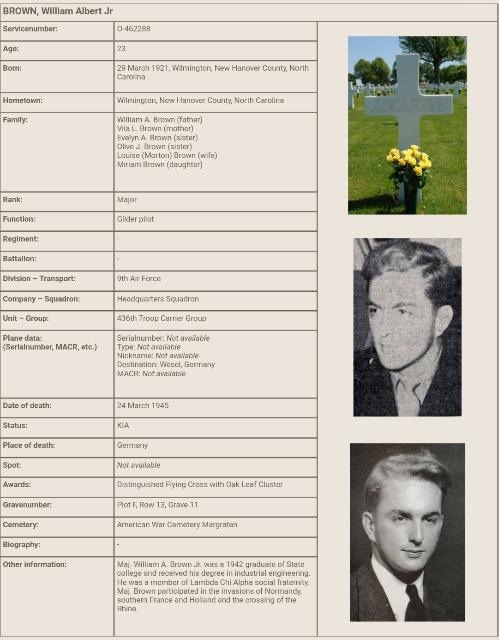
Major William A Brown,Jr.
Birth...29 March 1929
Wilmington,North Carolina
KIA...Operation "Varsity"
24 March 1945 Germany
Glider Pilot
Headquarters Squadron
436th Troop Carrier Group
Birth...29 March 1929
Wilmington,North Carolina
KIA...Operation "Varsity"
24 March 1945 Germany
Glider Pilot
Headquarters Squadron
436th Troop Carrier Group
Lt John Reid Denton,Jr
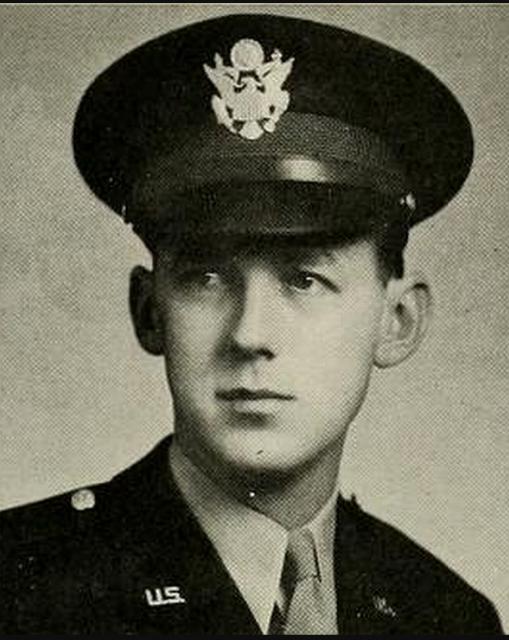
Lt. John R Denton, Jr.
Birth: 1 January 1920...Raleigh, North Carolina
Death: 27 July 1943 Germany
Pilot...B-17..."Mister Yank"
3i8th Bomb Group
562nd Bomb Squadron
"If ye break faith with us who die...we shall not sleep "
Another Purple sold last Friday night at a auction...no place to go...just a Collector doing what we do...saving American History one medal at a a time..
Birth: 1 January 1920...Raleigh, North Carolina
Death: 27 July 1943 Germany
Pilot...B-17..."Mister Yank"
3i8th Bomb Group
562nd Bomb Squadron
"If ye break faith with us who die...we shall not sleep "
Another Purple sold last Friday night at a auction...no place to go...just a Collector doing what we do...saving American History one medal at a a time..
Corporal William P Tayse
Corporal William P Tayse
ser#34254928
Co B Anti Tank Gun Crew
48th Armored Inf Battalion
7th Armored Division
KIA...24 December 1944
Manay Belgium
FROM...Statesville,NC
ser#34254928
Co B Anti Tank Gun Crew
48th Armored Inf Battalion
7th Armored Division
KIA...24 December 1944
Manay Belgium
FROM...Statesville,NC


